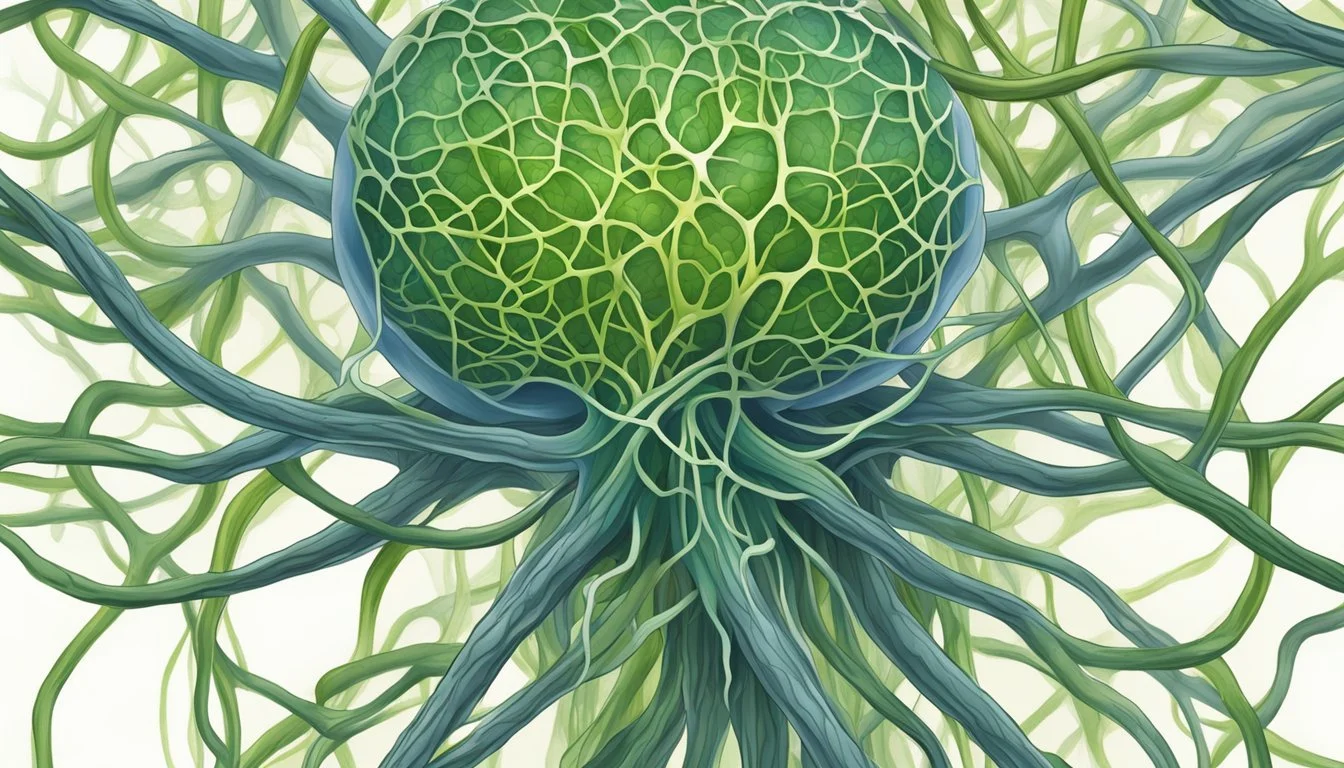The Lymphatic Benefits of Cleavers
Unlocking the Potential of a Traditional Herb
Cleavers, scientifically known as Galium aparine, is a common yet underappreciated herb that emerges in spring and offers significant benefits for the lymphatic system. Often unnoticed among more popular medicinal plants, cleavers has a long history of traditional use for supporting lymphatic health. The herb contains various bioactive compounds which are said to have a gentle cleansing effect, making it a favored choice for herbalists aiming to enhance lymphatic function and detoxification.
In the human body, the lymphatic system plays a crucial role in immune function and waste removal. Cleavers is believed to aid this system through its diuretic and anti-inflammatory properties. Traditionally, it has been used to encourage lymphatic drainage, helping to reduce lymphatic congestion and swelling. It is this attribute that has earned cleavers the reputation as a natural "cleanser" for the body's internal drainage system.
Available in various preparations, including juices, teas, and tinctures, cleavers is accessible for those seeking natural remedies to support their health. While the scientific community has not established standardized dosing guidelines, naturopathic practitioners commonly recommend specific formulations and dosages to maintain or enhance lymphatic function. As with any herbal remedy, recommendations for use should be tailored to individual needs and it is prudent to consult with a healthcare professional before adding cleavers to one’s wellness routine.
Cleavers, celebrated for its lymphatic benefits, has been revered for its potential to support the body's natural detoxification processes. This remarkable herb has been an integral part of traditional wellness practices, cherished for its ability to promote lymphatic health. When combined with maca root and aronia berries, Cleavers offers a holistic approach to supporting overall well-being, reflecting its enduring appeal in ancient and modern wellness traditions.
Furthermore, the addition of moringa, licorice root, and oil pulling further complements the lymphatic benefits of Cleavers, contributing to its reputation as a versatile and effective natural remedy. Additionally, the incorporation of jujube fruit and fenugreek into wellness practices alongside Cleavers has expanded the spectrum of potential health benefits, underscoring the enduring appeal of this remarkable herb.
In conclusion, Cleavers continues to be celebrated for its positive impact on lymphatic health, offering a natural solution for promoting overall well-being. Whether combined with maca root, aronia berries, moringa, licorice root, oil pulling, jujube fruit, or fenugreek, Cleavers remains a symbol of health and vitality, embodying the rich heritage of natural health practices.
Cleavers: Understanding the Basics
Cleavers, a humble yet potent herb, has a rich botanical profile and a notable history of use in herbal medicine. This section delves into its basic understanding, detailing the herb's identity and its traditional applications.
Botanical Profile
Scientific Name: Galium aparine
Common Names: Cleavers, Goosegrass, Sticky Weed, Velcro Plant, Grip Grass
Family: Rubiaceae
Description: They are easily recognized by their slender, climbing stems, whorled leaves, and fine, hair-like structures that make them adhere to other plants and materials. The tiny, greenish-white flowers bloom from spring into summer.
Historical Uses
Herbalists throughout history have harnessed the potential of Cleavers for various ailments. Referred to commonly as bedstraw because it was once used as a mattress stuffing material, Cleavers have also been a staple in traditional medicine for their ability to support the lymphatic system. This unassuming plant has been employed to soothe skin conditions, such as eczema and psoriasis, and to assist with urinary tract health.
Role in the Lymphatic System
Cleavers is a medicinal herb with a notable affinity for the lymphatic system. This system, integral to immune function, benefits from specific actions of cleavers.
Lymphatic Health
The lymphatic system comprises lymph, lymph nodes, and a network of vessels that work to maintain fluid balance and play a vital role in the body's immune response. Proper lymphatic health is essential for the filtration of toxins and for supporting immune system operations. Cleavers has a history of traditional use, suggesting that it assists lymphatic drainage and aids in reducing swollen glands.
Lymphatic Support Actions
Cleavers is purported to enhance the lymphatic system's function through its diuretic properties by helping to move waste from the tissues via the lymph. The herb works by stimulating the activity of the lymphatic system, thus promoting the clearing of toxins and maintaining lymphatic flow.
Support Actions of Cleavers:
Encouragement of lymphatic drainage
Potential reduction of lymph node swelling
Aid in the removal of metabolic waste
Through these actions, cleavers may support overall lymphatic health, contributing to a more effective immune response and potentially providing relief in cases of lymphatic congestion.
Skin Health Applications
Cleavers, known for its gentle yet effective support, offers several benefits relating to skin health, particularly in the realm of eczema, psoriasis, and acne.
Herbal Remedies for Skin Conditions
Cleavers has been traditionally used to soothe and mitigate symptoms of various skin conditions. Users find it beneficial for the cooling properties it imparts to inflamed skin, which can be particularly relieving for conditions like eczema and psoriasis. These inflammatory skin conditions often respond to the anti-inflammatory qualities of cleavers.
Eczema: Cleavers' anti-inflammatory action aids in reducing the redness and itching.
Psoriasis: The herb can contribute to the reduction of scaly, itchy patches on the skin.
Acne: Cleavers may help cool and calm the skin, potentially reducing redness and swelling associated with acne.
In application, a mild cleavers infusion can be used as a wash or a compress to apply directly to affected areas, providing a comforting effect on the skin.
Nutritional Profile and Skin Benefits
Cleavers contains a variety of compounds that support skin health, such as flavonoids, tannins, and vitamin C.
Flavonoids and Tannins: These act as antioxidants, protecting the skin cells from oxidative damage. Vitamin C: A key nutrient in collagen synthesis, vitamin C in cleavers contributes to skin's strength and elasticity.
Nutrient Benefit to Skin Flavonoids Antioxidant action Tannins Protective effect Vitamin C Supports collagen
The compounds in cleavers not only serve the skin's outer layer but also align with internal health benefits that reflect externally. A functioning lymphatic system, supported by cleavers, can result in a clearer and healthier complexion.
Cleavers as a Diuretic and Detoxifier
Cleavers is recognized for its diuretic effect that supports urinary tract health and facilitates body detoxification processes.
Supporting the Urinary Tract
Cleavers acts on the urinary system by promoting urine production and flow. This diuretic action is beneficial for alleviating urinary tract infections and bladder infections, where increased urination can help flush out bacteria. Regular consumption of cleavers aids in maintaining a cool and functional bladder lining, aiding those with complications in the urinary tract.
Detoxification Properties
The detoxifying properties of cleavers stem from its ability to enhance the elimination of waste products. It plays a role in reducing swelling and water weight by encouraging the removal of excess fluid from the body. As a cleansing herb, cleavers supports lymphatic health—an essential system for detoxification—by assisting in the movement and filtration of lymphatic fluids throughout the body.
Preparation and Use of Cleavers
Cleavers is a versatile herb that one can prepare in various ways to harness its lymphatic benefits. Whether brewed as an infusion or incorporated into meals, the preparation methods are straightforward and accessible.
Creating Infusions and Teas
To bring forward the lymphatic advantages of cleavers, an herbal infusion or tea is often the method of choice. Prepare a cleavers tea by steeping 1/4 cup of fresh, coarsely chopped herb or 1 tablespoon of dried cleavers in one cup of hot water. It's critical to avoid boiling water as high temperatures may degrade some of the herb's beneficial properties. The correct procedure is as follows:
Heat water until hot but not boiling.
Add the cleavers—1/4 cup fresh or 1 tablespoon dried—to the hot water.
Allow the mixture to steep for at least 30 minutes.
Strain the mixture to remove the herb residue.
Enjoy this tea hot or let it cool for a refreshing, healthful drink. For a more potent preparation, one could produce a tincture which involves soaking the herb in alcohol for several weeks, though this process is more intricate and time-consuming.
Cooking and Edible Uses
Cleavers doesn't only lend itself to teas and tonics; it can also be a nutritious addition to food. The tender leaves of cleavers can be eaten raw and have a place in salads or sandwiches, offering a crisp texture and light green flavor. When it comes to cooking, one can blanch the leaves briefly and add them to soups, imparting a subtle taste and increasing the meal's nutritional profile.
Creating a cleavers vinegar is feasible and beneficial for long-term storage and use:
Fill a quart jar halfway with loosely chopped cleavers.
Use a stirrer to ensure the cleavers are settled, and no air pockets remain.
Cover the herb with organic apple cider vinegar, sealing the plant material.
Store in a cool, dark place, shaking periodically for a few weeks.
Strain the vinegar for use.
This vinegar can then be used as a dressing for salads, added to sauces, or used in any recipe calling for vinegar, adding a healthful touch to your diet. Whether you choose to make an infusion or use cleavers in cooking, the plant's seasonal virtues support the lymphatic system and general well-being.
Health Benefits Beyond the Lymphatics
Cleavers, traditionally heralded for its lymphatic benefits, also extends its therapeutic qualities to other body systems.
Support for the Cardiovascular and Immune System
Cleavers is believed to possess certain cardiovascular benefits, primarily through its diuretic properties. This effect can aid in reducing hypertension, a major risk factor for heart disease. By promoting the flushing of excess fluids from the body, blood volume and blood pressure may be managed more effectively.
For the immune system, cleavers' ability to stimulate lymphatic drainage enhances the clearance of toxins and supports immune health. The herb facilitates lymph flow, which is crucial for transporting white blood cells throughout the body and ensuring optimal immune function.
Potential Anti-inflammatory and Cancer-Related Uses
Containing various anti-inflammatory compounds, cleavers helps diminish inflammation, which can mitigate the symptoms of skin conditions like eczema and psoriasis. The anti-inflammatory effects also contribute to a general reduction in inflammation-related discomfort.
In terms of potential cancer-related uses, cleavers is under investigation for its various therapeutic plant compounds. While research is not definitive, the presence of these compounds suggests a role in cancer prevention strategies, as they may inhibit tumor growth and support the destruction of cancerous cells. Nevertheless, it is important to approach these findings with cautious optimism and to acknowledge that clinical evidence is necessary to substantiate such claims.
Integrating Cleavers with Other Herbs
When used in combination, herbs can often enhance each other's properties. In the context of lymphatic health, cleavers can be paired effectively with certain herbs to target specific wellness goals.
Synergies with Dandelion and Burdock
Dandelion (Taraxacum officinale) is renowned for its diuretic properties, especially the dandelion leaf. It promotes the elimination of toxins through the kidneys and can complement cleavers in supporting lymphatic drainage.
Dandelion leaf: Enhances urinary output, thereby supporting the lymphatic system.
Cleavers: Serves to support the lymphatic system as well.
Integrating cleavers with dandelion can result in a more thorough detoxification process, as the two herbs work together to facilitate waste elimination through different pathways.
Burdock (Arctium lappa) is another herb that is commonly used for its blood-purifying actions. It can be combined with cleavers to mutually reinforce the cleansing of the lymphatic and circulatory systems.
Burdock root: Known for supporting blood purification and skin health.
Cleavers: Aids in lymphatic detoxification.
Herbal Combinations for Enhanced Efficacy
A well-formulated herbal remedy often contains a combination of herbs chosen for their complementary actions. When cleavers is included in an herbal mixture, its lymphatic benefits can be amplified.
Herbal remedies: These often include a variety of herbs that support different aspects of health, like liver function, digestion, and immune response.
Edible weed: Cleavers, often overlooked, is actually an edible weed with considerable medicinal potential, particularly when combined with other herbs.
By carefully selecting herbs that have synergistic effects, the efficacy of cleavers in promoting lymphatic health can be significantly enhanced. It’s important to select combinations based on the individual’s specific health needs and to consult with a healthcare professional well-versed in herbal medicine for personalized advice.
Harvesting and Preserving Cleavers
In optimizing the lymphatic benefits of cleavers, proper harvesting and preservation are essential. These methods ensure the plant's medicinal properties are retained effectively.
Best Practices for Harvesting
One should harvest cleavers when they are at their most vigorous, typically in early spring or early summer. It is crucial to select fresh cleavers, which should be green and vibrant. The stems are particularly valuable and should be harvested by carefully cutting them near the base to preserve the integrity of the plant. One should avoid harvesting in areas where pesticides or pollutants are present, to maintain the purity of the herb.
Select vibrant green stems.
Harvest early spring or early summer for peak vitality.
Cut stems near the base, use sharp scissors.
Avoid polluted areas to ensure purity.
Preservation Techniques
Cleavers can be preserved either by drying or by making an infusion. To dry cleavers, one must spread the stems in a thin layer in a well-ventilated, dry space away from direct sunlight. This method can take several days, and one should ensure the cleavers are completely dry before storing to prevent mold.
To make a dried cleavers infusion, steep 1 heaping tablespoon of dried cleavers in 1 cup of hot water, avoiding boiling water to retain the herb's properties. After 30 minutes, strain and the infusion can be consumed hot or cold. Properly dried cleavers can also be stored in an airtight container for future use.
For drying:
Spread in a thin layer in a dry, well-ventilated area.
Ensure complete drying to prevent mold.
Store in an airtight container.
For infusion:
Use 1 heaping tablespoon dried cleavers per 1 cup of hot water.
Steep for 30 minutes, then strain.
Consume hot or cold; store infusion in the refrigerator.
Safety and Precautions
Before incorporating cleavers into one's health regimen as a lymphatic cleansing agent, it is paramount to acknowledge the safety and precautionary measures associated with this herb. Although cleavers offer health benefits, especially for the immune system and swollen glands, one should exercise caution to avoid potential side effects and contraindications.
Potential Side Effects and Contraindications
Cleavers might generally be safe for most people when used in moderation. However, there are potential side effects that may manifest, especially when taken in excess or without proper guidance. These side effects include:
Skin irritation when the herb is applied topically.
Gastrointestinal discomfort, such as nausea or diarrhea, which may occur with overconsumption.
Patients with certain conditions should consult a healthcare practitioner before using cleavers, as there could be contraindications with:
Blood-thinning medications: Cleavers may have a blood-thinning effect, which could amplify the action of anticoagulant drugs.
Diuretic medications: As cleavers act as a natural diuretic, combining with other diuretics may lead to dehydration or electrolyte imbalances.
Existing kidney conditions: The diuretic effect could exacerbate kidney issues.
Pregnant and breastfeeding women are advised to avoid cleavers due to a lack of safety information.
Sensible Use Recommendations
When considering cleavers for its cleansing properties and potential to boost the immune system, one should:
Start with small doses to gauge the body's reaction.
Consult with a healthcare provider if taking any medication, to prevent possible interactions.
Seek guidance from qualified professionals in herbal medicine to determine appropriate dosing.
For use as a food ingredient, such as in salads or as a cooked green, ensure that the plant is properly identified and harvested from areas free of pesticides and pollutants.
Lastly, it's important to source cleavers from reputable suppliers to ensure purity and to avoid contamination that could lead to infection or other adverse health effects.






